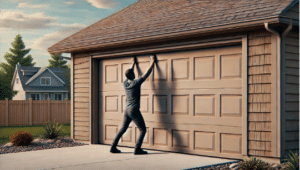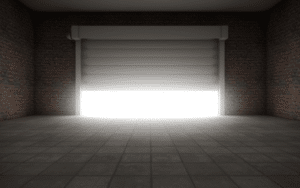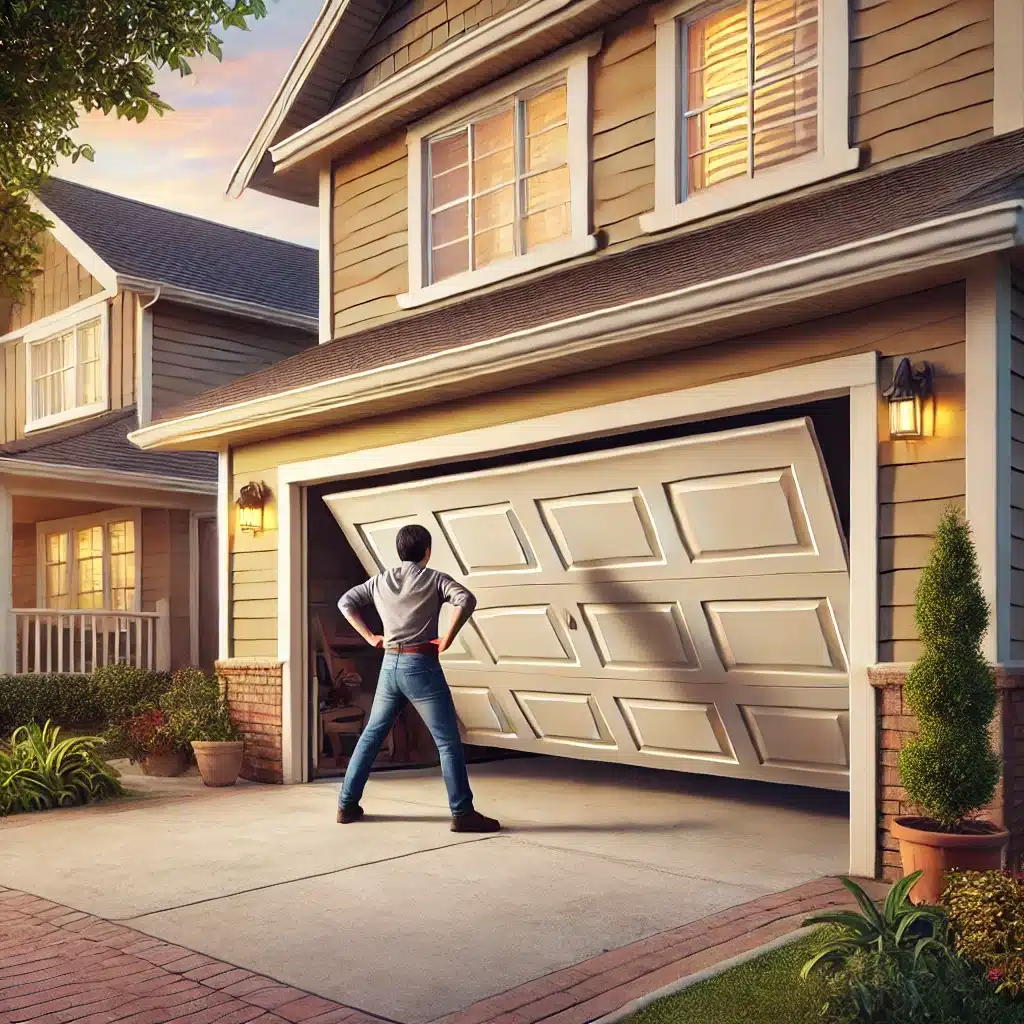Open Garage Door Manually From Outside and Inside when the automatic system fails, whether due to a power outage or malfunction. Knowing how to manually operate your garage door can be a real time-saver when you’re locked out, or the opener isn’t responding.

In this guide, we’ll explain how to safely open your garage door manually from both the outside and inside. You’ll learn how to use an emergency release kit from the outside and how to disengage the opener from the inside to lift the door by hand.
We’ll also provide helpful tips for resetting the garage door opener once the issue is resolved. Keep reading to understand how to manage your garage door in any situation!
Important Things You Should Know Before Opening Your Garage Door Manually
Before manually opening your garage door, it’s important to understand a few key points. These will help ensure your safety, protect your garage door system, and prevent further damage.
1. Disconnect the Automatic Opener Safely
Most garage doors today are operated by automatic openers. To open the door manually, you must first disengage the opener from the door. This is crucial because forcing the door open while it’s still connected to the opener can damage the motor and the tracks and even be dangerous. By disconnecting the opener properly, you avoid harming the door’s components or risking injury.
2. Familiarize Yourself with the Garage Door Type
Generally, two garage door systems are torsion spring and extension spring doors. Torsion springs are mounted above the garage door, while extension springs run along the sides. Knowing which type of system you have is essential because torsion springs are tense, making them more dangerous to handle. If your garage door has torsion springs, exercise extra caution, as these springs can snap if improperly handled.
3. Know the Weight of Your Garage Door
Garage doors, especially large two-car models, are heavier than most people expect. Depending on the material, a typical two-car garage door can weigh anywhere from 150 to 300 pounds. Lifting such a heavy door manually requires caution and proper technique to avoid straining your back or causing injury. Always lift with your legs, not your back, and get help if the door is too heavy to manage alone.
4. Keep Safety in Mind
It’s vital to ensure that the area around the garage door is clear when manually opening or closing it. Keep children, pets, and other people at a safe distance. A garage door can fall quickly if it’s not properly supported, and it can cause serious injury. Ensure you take your time, use controlled movements, and keep a clear workspace when manually handling a garage door.
5. Prepare for Power Outages in Advance
In case of power outages, planning and installing a battery backup system or an emergency release kit for your garage door opener is wise. These systems will allow you to open the garage door easily without needing to disengage the opener manually. Emergency release kits, installed outside your garage door, allow you to pull a cable to disengage the opener from outside. Having these tools can be extremely helpful if you live in an area prone to power outages.
Step-by-Step Guide to Opening Your Garage Door Manually
Whether you’re locked outside your garage or dealing with an opener malfunction, knowing how to open the door manually is crucial. The process differs slightly depending on whether you are outside or inside.
How to Open a Garage Door from the Outside

If you’re locked outside due to a power outage or malfunction, you can still open the garage door manually. Below are the steps for safely accessing and opening the door from the outside.
1. Using an Emergency Release Kit
An emergency release kit is a special lock or keyhole installed outside the garage door. This system is designed to let you disengage the opener from the door when you don’t have access to the inside.
Steps:
- Locate the emergency release kit: Look for a small lock or keyhole in the center of the garage door, usually just above the handle.
- Insert the key and unlock the kit: This key will allow you to open the kit and access the emergency release cable inside.
- Pull the emergency release cable: This cable will disconnect the garage door from the automatic opener. You will now be able to lift the door manually.
- Lift the door manually: Once disengaged, stand in front of it, grip the bottom panel, and lift evenly from both sides. Be sure to lift with your legs to avoid injury.
2. Access Through a Side or Back Door
If your garage has a separate entrance, such as a side or back door, you can use this to get inside and manually disengage the garage door opener from the inside. This is often easier than trying to open the door from the outside.
3. Smart Garage Door Openers
If you have a smart garage door opener installed, you may be able to open the door via your smartphone, even if you’re locked out. Many modern garage doors have mobile app integration, allowing you to operate the door remotely if the system is connected to your home’s Wi-Fi.
How to Open a Garage Door from the Inside

When you are inside the garage and need to open the door manually, you can follow these steps to ensure the process is smooth and safe.
1. Disengage the Automatic Opener
The first step is disengaging the garage door opener from the door itself. This will allow you to lift the door manually without interference from the motor.
Steps:
- Locate the emergency release cord: This red cord or rope usually hangs from the garage door track near the opener motor. It’s easy to spot and is designed specifically for manual disengagement.
- Pull the red cord down: Firmly pull the cord downward to disengage the door from the opener. Once the door is disconnected, the opener will no longer control its movement, and you can operate it manually.
2. Lift the Door Manually
After disengaging the opener, the next step is to lift the door manually.
Steps:
- Grasp the door firmly: Stand at the center or near the bottom of the garage door. Use both hands to grip the door evenly, ensuring a firm hold.
- Lift the door: Lift the door slowly and steadily using your legs. Be sure to use controlled movements and avoid any jerking motions, as this can cause the door to go off-track.
- Prop the door open if necessary: If the garage door is heavy and won’t stay open, prop it open with a sturdy object such as a wooden board. Never rely on the door staying in place if it feels heavy or unstable.
3. Closing the Door Manually
To close the door manually, reverse the process. Slowly lower the door while keeping a firm grip. Be cautious when bringing the door down, as the full weight will come into play once you start lowering it.
Resetting the Garage Door Opener After Manual Operation
Once you’ve manually opened or closed the garage door and power has been restored or the opener issue has been resolved, you’ll need to reset the opener to restore automatic function. Here’s how to reset your garage door opener.

1. Reconnect the Opener
To return to normal automatic operation, the garage door needs to be reconnected to the opener.
Steps:
- Locate the opener trolley: The trolley is the component that connects the garage door to the opener’s track. After manual operation, it will be disengaged.
- Pull the emergency release cord: Pull the red cord down and toward the door. This will return the trolley to its original position and reconnect it to the opener.
- Close the garage door manually: If it is open, close it fully before attempting to engage the opener.
2. Operate the Opener to Test
Test the opener once the door is reconnected by pressing the button on your remote control or wall switch. The opener should function properly and engage the door, moving it along the tracks as usual.
3. Check for Any Issues
If the opener doesn’t function correctly or if the garage door doesn’t move smoothly, double-check the alignment of the door and tracks. Ensure there are no obstructions and that the door is balanced. If issues persist, consult a garage door professional for further inspection or repairs.
Additional Troubleshooting Tips for Garage Door Opener Issues
If your garage door opener is having problems after manual operation, there could be other underlying issues affecting the door’s functionality. Here are a few common problems and solutions.
1. Opener Not Responding
Check the power source if your garage door opener isn’t responding to the remote or wall switch. Make sure the opener is plugged in and that the circuit breaker is not damaged. Replacing the batteries in your remote can also fix this problem.
2. Door Doesn’t Close Fully
If the garage door closes partway and reverses, the safety sensors may be misaligned or blocked. Ensure that the sensors are clean and pointing directly at each other. Misaligned sensors are a common reason for doors refusing to close.
3. Noisy Operation
If your garage door makes unusual noises when opening or closing, this could be a sign of worn-out rollers, lack of lubrication, or loose hardware. Inspect the rollers and hinges, and apply a silicone-based lubricant to reduce friction and noise.
Regular Maintenance for Smooth Operation

Regular maintenance is essential to avoid future issues with your garage door. Simple steps such as lubricating moving parts, inspecting the tracks for debris, and testing the door’s balance can prevent costly garage door repairs.
1. Lubricate the Moving Parts
Apply lubrication to the garage door’s moving components, such as the hinges, rollers, and springs. This helps reduce friction and extends the lifespan of these parts. Use a silicone-based lubricant to avoid the mess that comes with oil-based products.
2. Inspect the Tracks
Ensure that the tracks are free of dirt, debris, or rust. Clean the tracks regularly, and if you notice any dents or misalignment, repair them immediately to prevent the door from coming off track.
3. Test the Door’s Balance
A balanced door will stay in place when lifted halfway. If the door falls or rises quickly, the springs may need adjustment. In this case, it’s best to consult a professional to handle the spring adjustment, as springs are under high tension and can be dangerous.
Frequently Asked Questions (FAQs)
How do you manually open an automatic roller door?
Pull the emergency release cord, usually red, to manually open an automatic roller door, which disengages the door from the motor. Once disengaged, you can manually lift the door. After resolving the issue, reattach the door to the motor by resetting the release mechanism.
How do you make a door unable to open from the outside?
To prevent a door from opening from the outside, you can install a deadbolt or door bar for extra security. Locking mechanisms with interior controls, like chain locks or slide bolts, also prevent outside entry. For automated doors, temporarily disabling the remote access system can help.
How to open a garage door from the outside with a broken cable?
To open a garage door with a broken cable, you’ll need to access the emergency release from the outside. If there’s no access to the interior, use a coat hanger or similar tool to pull the release cord through the top of the door panel. This disengages the door from the opener, allowing you to lift the door manually.
Can I open my garage door without the garage door opener?
You can open your garage door without the opener by using the emergency release cord. This cord, usually red and hanging from the opener track, disconnects the door from the automatic opener, allowing you to lift it manually. Once disengaged, you can open or close the door by hand.
How do you override a locked garage door?
To override a locked garage door, use the emergency release cord to disengage the door from the opener system. If the door is physically locked, you may need to unlock it using a key or manually open the locking mechanism from the inside. Ensure you reset the opener after unlocking it to return it to automatic mode.
Conclusion
Knowing how to manually open your garage door from both the inside and outside is a valuable skill that can save you from frustration during power outages or malfunctions. By following the steps outlined in this guide, you can confidently open, close, and reset your new garage door system. Always prioritize safety, perform regular maintenance, and call a professional when needed. With proper care and attention, your garage door will continue functioning smoothly for years.
End Note
At Tarrant County Door & Gate, we know how critical it is to regain access to your garage when your automatic system fails. Whether it’s a broken spring, a power outage, or malfunctioning garage door remote controls, our expert team is ready to assist with all your garage door needs. From garage door service to repair, we’re proud to offer solutions, including emergency garage door service.
Serving Tarrant County, Keller, Southlake, and beyond, we ensure fast, professional service every time. See our work in action on our gallery or learn more about our team here. Have a question? Reach out to us here or explore our latest tips and insights on our blog. Need more than just garage doors? Check out our drive gate services here. We’re here to keep you in control, no matter the situation!

